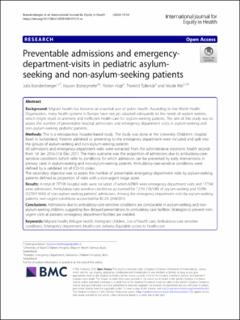| dc.contributor.author | Brandenberger, Julia | |
| dc.contributor.author | Bozorgmehr, Kayvan | |
| dc.contributor.author | Vogt, Florian | |
| dc.contributor.author | Tylleskär, Thorkild | |
| dc.contributor.author | Ritz, Nicole | |
| dc.date.accessioned | 2021-08-09T08:02:50Z | |
| dc.date.available | 2021-08-09T08:02:50Z | |
| dc.date.created | 2021-03-18T22:20:06Z | |
| dc.date.issued | 2020 | |
| dc.identifier.issn | 1475-9276 | |
| dc.identifier.uri | https://hdl.handle.net/11250/2766874 | |
| dc.description.abstract | Background
Migrant health has become an essential part of public health. According to the World Health Organization, many health systems in Europe have not yet adapted adequately to the needs of asylum-seekers, which might result in untimely and inefficient health care for asylum-seeking patients. The aim of this study was to assess the number of preventable hospital admissions and emergency department visits in asylum-seeking and non-asylum-seeking pediatric patients.
Methods
This is a retrospective, hospital-based study. The study was done at the University Children’s Hospital Basel in Switzerland. Patients admitted or presenting to the emergency department were included and split into the groups of asylum-seeking and non-asylum-seeking patients.
All admissions and emergency-department visits were extracted from the administrative electronic health records from 1st Jan 2016-31st Dec 2017. The main outcome was the proportion of admissions due to ambulatory-care-sensitive conditions (which refer to conditions for which admission can be prevented by early interventions in primary care) in asylum-seeking and non-asylum-seeking patients. Ambulatory-care-sensitive conditions were defined by a validated list of ICD-10 codes.
The secondary objective was to assess the number of preventable emergency-department visits by asylum-seeking patients defined as proportion of visits with a non-urgent triage score.
Results
A total of 75′199 hospital visits were included, of which 63′405 were emergency department visits and 11′794 were admissions. Ambulatory-care-sensitive conditions accounted for 12.1% (18/149) of asylum-seeking and 10.9% (1270/11645) of non-asylum seeking patients’ admissions. Among the emergency department visits by asylum-seeking patients, non-urgent conditions accounted for 82.2% (244/297).
Conclusions
Admissions due to ambulatory-care-sensitive conditions are comparable in asylum-seeking and non-asylum-seeking children, suggesting few delayed presentations to ambulatory care facilities. Strategies to prevent non-urgent visits at pediatric emergency department facilities are needed. | en_US |
| dc.language.iso | eng | en_US |
| dc.publisher | BMC | en_US |
| dc.rights | Navngivelse 4.0 Internasjonal | * |
| dc.rights.uri | http://creativecommons.org/licenses/by/4.0/deed.no | * |
| dc.title | Preventable admissions and emergency-department-visits in pediatric asylum-seeking and non-asylum-seeking patients | en_US |
| dc.type | Journal article | en_US |
| dc.type | Peer reviewed | en_US |
| dc.description.version | publishedVersion | en_US |
| dc.rights.holder | Copyright The Author(s). 2020 | en_US |
| dc.source.articlenumber | 58 | en_US |
| cristin.ispublished | true | |
| cristin.fulltext | original | |
| cristin.qualitycode | 1 | |
| dc.identifier.doi | 10.1186/s12939-020-01172-w | |
| dc.identifier.cristin | 1899164 | |
| dc.source.journal | International Journal for Equity in Health | en_US |
| dc.identifier.citation | International Journal for Equity in Health. 2020, 19, 58. | en_US |
| dc.source.volume | 19 | en_US |

